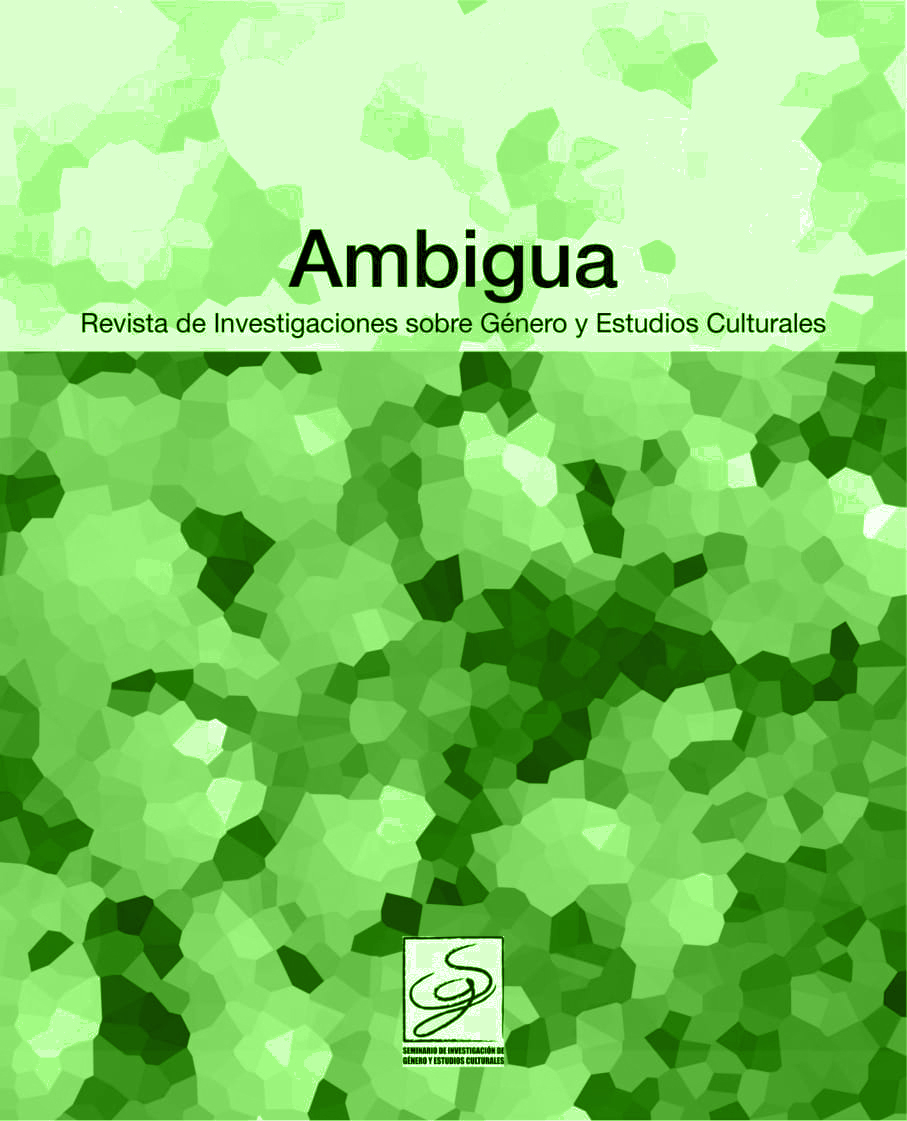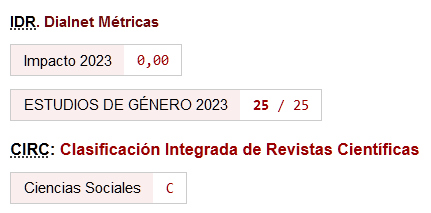Gothic Noir Filmic Male Gaze: Gender Stereotyping in Margaret Atwood’s “The Freeze-Dried Groom”
DOI:
https://doi.org/10.46661/ambigua.5899Palabras clave:
estereotipos de género, mirada patriarcal, mujer atrapada, mujer fatal, cine negro gótico, investigador privadoResumen
Los estereotipos han sido cruciales en las representaciones artísticas, especialmente en el cine, para la construcción de paradigmas de género. Los hombre y las mujeres han sido retratados mediante clichés simplificados y poco realistas con el propósito de controlarlos y constreñirlos a roles y convenciones patriarcales promoviendo sus ideologías sociales normativas. Las mujeres del cine negro son proyecciones de las ansiedades masculinas acerca de la sexualidad e independencia femeninas. En “The Freeze-Dried Groom,” Atwood revela los estereotipos de género a través de una mirada masculina típica del cine negro en tres de sus personas tipos: la mujer atrapada, el “detective” y la mujer fatal. Así, Atwood describe a una mujer fatal para reflexionar no sólo sobre este personaje del cine negro, sino también sobre la identidad femenina, la dinámica de género y el feminismo. Atwood denuncia y critica la institución matrimonio-familia y la sociedad patriarcal en su conjunto.
Descargas
Citas
ALLEN, Virginia. The Femme Fatale: Erotic Icon. Troy: Whitston, 1983.
ATWOOD, Margaret. Stone Mattress. London: Virago, 2014.
BLASER, John, and Stephanie Blaser. “No place for women: The family in film noir.” Film Noir Studies. 2008. Accessed April 22, 2020 http://www.filmnoirstudies.com/essays/no_place5.asp.
BREU, Christopher. “Radical Noir: Negativity, Misogyny, and the Critique of Privatization in Dorothy Hughes’ In a Lonely Place.” Modern Fiction Studies 55, no. 2 (2009): 199-215.
CAMDEM, Carrol. The Elizabethan Woman. New York: Appel, 1975.
COHAN, Steven. Masked Men: Masculinity and the Movies in the Fifties. Bloomington: Indiana UP, 1997.
DICKENS, Charles. Great Expectations. London: Collins Classics, 2010.
DUNCAN, Cynthia. Unraveling the Real: The Fantastic in Spanish-American Ficciones. Philadelphia: Temple UP, 2010. Print.
DUNN, Catherine M. “The Changing Image of Woman in Renaissance Society and Literature.” In What Manner of Woman, edited by Marlene Springer, 15-38. New York: NYU Press, 1977.
FARRIMOND, Katherine. The Contemporary Femme Fatale: Gender, Genre and American Cinema. New York: Routlege, 2017.
GAVINS, Joanna. Text World Theory an Introduction. Edinburgh: Edinburgh UP, 2007.
GILL, Ivinder. “A matter of perspective.” Financial Express, 16 Nov. 2014, accessed May 11, 2020, https://www.financialexpress.com/author/ivinder-gill/
HARRISON, Chloe and Louise Nuttall. “Cognitive Grammar and Reconstrual: Re-Experiencing Margaret Atwood’s ‘The Freeze-Dried Groom’.” In Experiencing Fictional Worlds, edited by Benedict Neurohr and Lizzie Stewart-Shaw, 135-57. Amsterdam: Benjamins, 2019, accessed May 15, 2020,
https://pdfs.semanticscholar.org/f452/a8e8d63a70ba2eb0601f4639cc2bb07c0bd3.pdf
HILMES, Carola. Die Femme Fatale. Ein Weiblichkeitstypus in der nachromantischen Literatur. Stuttgart: Metzler, 1990.
HOOKS, bell. “Moving Beyond Pain.” Web blog post. bell hooks Institute. Berea College, 9 May 2016, accessed May 3, 2020,
http://www.bellhooksinstitute.com/blog/2016/5/9/moving-beyond-pain
KAPLAN, E. Ann. Women and Film: Both Sides of the Camera. New York: Methuen, 1983.
KELLNER, Douglas. “Toward a Critical Media/Cultural Studies.” In Media/Cultural Studies: Critical Approaches, edited by Hammer, Rhonda and Douglas Kellner, 5-25. New York: Peter Lang, 2009.
KRUTNIK, Frank. In a Lonely Street: Film Noir, Genre, Masculinity. London: Routledge, 2006.
KÜHL, Sarah. “The Angel in the House and Fallen Women: Assigning Women their Places in Victorian Society.” 171-178. open.conted.ox.ac.uk, July 11, 2016, accessed March 10, 2020, https://open.conted.ox.ac.uk/resources/documents/angel-house-and-fallen-women-assigningwomen-their-places-victorian-society
LINDOP, Samantha. Postfeminism and the Fatale Figure in Neo-Noir Cinema. New York: Palgrave Macmillan, 2015.
MACIEK, Rev. Stone Mattress. Goodreads 2 November 2014, accessed February 5, 2020, https://www.goodreads.com/review/show/1095567292
MAXFIELD, James. The Fatal Woman: Sources of Male Anxiety in American Film Noir, 1941-1991. London: Associated University Presses, 1996.
MORRIS, Gary. “High Gallows: Revisiting Jacques Tourneur's ‘Out of the Past’.” Bright Lights Film Journal. 2000, accessed January 21, 2020, http://brightlightsfilm.com/high-gallowsrevisiting-jacques-tourneurs-past/#.VO9jyVPF84S
MULVEY, Laura. “Visual Pleasure and Narrative Cinema.” In Film Theory and Criticism: Introductory Readings, edited by Leo Braudy and Marshall Cohen, 833-44. New York: Oxford UP, 1999.
PLACE, Janey. “Women in Film Noir.” In Women in Film Noir, edited by E. Ann Kaplan, 47-68. London: BFI Pub, 1998.
SCHNEIDER, David J. The Psychology of Stereotyping. New York: Guilford Press, 2004.
SHERWIN, Miranda. “Deconstructing the Male: Masochism, Female Spectatorship, and the Femme Fatale in Fatal Attraction, Body of Evidence, and Basic Instinct.” Journal of Popular Film and Television 35, no. 4 (2008): 174-82.
“SHORTCUTS: Margaret Atwood’s Stone Mattress, Eliza Robertson’s Wallflowers: An Icon’s Return to Always-Slippery Form and an Ambitious Debut Collection.” National Post 12 September 2014, accessed 2 April, 2020, https://nationalpost.com/entertainment/books/shortcuts-margaret-atwoods-stone-mattress-eliza-robertsons-wallflowers
SPICER, Andrew. Film Noir. New York: Routledge, 2014.
SUTTON, Halley. “The Evolution of the Femme Fatale in Film Noir.” Crime Reads 5 December 2019, accessed March 28, 2020, https://crimereads.com/the-evolution-of-the-femme-fatale-in-film-noir/
WAGER, Jans B. Dangerous Dames: Women and Representation in the Weimar Street Film and Film Noir. Ohio: Ohio UP, 1999.
WAGER, Jans B. Dames in the Driver Seat. Austin: Texas UP, 2005.
Descargas
Publicado
Cómo citar
Número
Sección
Licencia
Derechos de autor 2021 MANUELA LOPEZ RAMIREZ

Esta obra está bajo una licencia internacional Creative Commons Atribución-NoComercial-CompartirIgual 4.0.
Las autorías que publican en esta revista están de acuerdo con los siguientes términos:
- Los autores conservan los derechos de autor y garantizan a la revista el derecho de ser la primera publicación del trabajo al igual que licenciado bajo Licencia Creative Commons Atribución-NoComercial-CompartirIgual 4.0 Internacional la publicación inicial en esta revista: Attribution-NonCommercial-ShareAlike 4.0 International (CC BY-NC-SA 4.0)
- Las autorías pueden establecer por separado acuerdos adicionales para la distribución no exclusiva de la versión de la obra publicada en la revista (por ejemplo, situarlo en un repositorio institucional o publicarlo en un libro), con un reconocimiento de su publicación inicial en esta revista.
- Se permite y se anima a las autorías a difundir sus trabajos electrónicamente (por ejemplo, en repositorios institucionales o en su propio sitio web) antes y durante el proceso de envío, ya que puede dar lugar a intercambios productivos, así como a una citación más temprana y mayor de los trabajos publicados (Véase The Effect of Open Access) (en inglés).
- Esta revista no cobra por publicar, es decir, no tiene APC's (the journal does not have article processing charges)
- Esta revista tampoco cobra ninguna tasa por el envío/presentación de trabajos (the journal does not have article submission charges)









